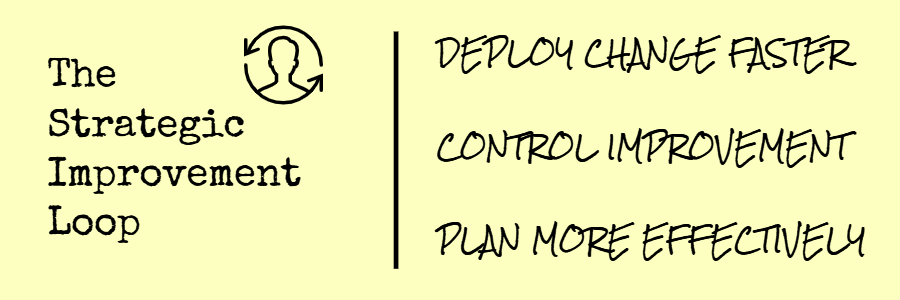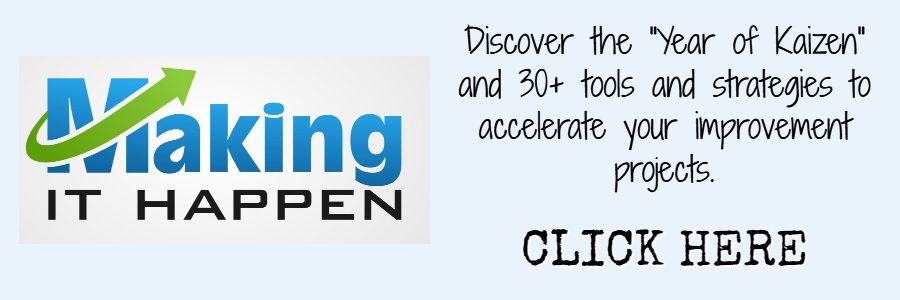Generating continuous improvement ideas can be a challenge for many businesses. Once you have moved past the immediate problems you face in the business, where do you go from there?
There are many obvious solutions to this challenge. You can hold team improvement meetings, set up a Kaizen programme, hold waste walks, raise concerns etc…
Whilst moving from ‘OK’ to ‘amazing’ is a different journey compared to ‘struggling’ to ‘OK’, these approaches can work well. Embracing a Lean improvement methodology can really bring with it a raft of benefits, let alone become the springboard for additional improvement ideas.
A good question
A good question to ask here is, how do you maximise the principle of a good improvement methodology?
Too many times, I see improvement methodologies used in isolation within organisations. The improvement’s true potential doesn’t appear. Just because you apply an idea to one area of your business doesn’t mean it can’t be applied elsewhere.
Or, put it another way, good ideas are often stuck in one area of the business, rarely escaping the world of operations (into management). Pigeon holing approaches as either operational or management doesn’t help us to maximise the improvements we can achieve for our organisations.
From operations to management
Many of the Lean approaches that I use with my clients focus on the operational world. Thankfully, with some badgering, my clients have taken the core principle of these improvement methodologies and applied them to their management approach and systems.
The benefit of applying these ideas into management is the amplification of the results themselves. If you improve an operational process you end up with a better process (in itself a great outcome). If you apply the same basic ideas to a management process then you potentially multiply the gains you can achieve operationally. Every operational process that ties into one management process improves.
Let’s say, for example, your operational process is hampered by slow decision making from the management team, or suffer from a mis-match with resource levels. By improving the management process, a streamlined version may be much better at turning around decisions and determining dynamic resource levels. This same benefit would then be felt by each process relating to this one improvement.

Translate the ideas
Translating these continuous improvement ideas is simply a case of stripping back the methodology and looking at the principle behind the idea. From here you can take the idea and twist it, and bend it, to suit your organisation.
Let me give you some examples of how to apply great Lean ideas into your management team.
The intention of these examples is to give you some food for thought and is not meant to be exhaustive!
SMED
…Single Minute Exchange of Dies (aka quick changeover).
The principle here is to look at how you prepare for a changeover by rearranging the work content and then streamline what is left.
What if you apply this approach to management meetings where a small amount of preparation beforehand allowed the meetings to be shorter and more effective?
Kaizen
…tiny improvement steps to avoid procrastination with regards to change and progress.
The principle here is to ensure change happens by avoiding the ‘fight or flight’ response in the brain by utilising small steps to see progress happen.
What if you used this tactic to split up and progress management decisions, so that your business plans can come to fruition faster?
Routines
…deciding what needs to be done when by whom, to provide consistency to business activity.
The principle here is that a firm routine will produce appropriate habits and hence results. A good routine should stop small (easy to forget) items becoming crises later on.
What if the management team / Board had a routine, just like your operatives do? What issues, or tasks, do you keep forgetting about and become a crisis later on? Naming the issues and creating a loose routine could really help to avoid this situation.
KanBan
…a visual pull system used within Lean production systems (not the card system based on the same idea!)
The principle here is to regulate supply against demand (this feature is often missing from the card versions). If there is no demand, don’t supply. This approach prevents overloading and helps you to identify the bottlenecks in your business.
What about linking this idea to your business planning by breaking up the tasks into stages, agree the number of items that can be in any stage at any one time and only progress items in line with the completion of tasks. If you can design the tasks to be about the same kind of size (work content wise) then you could visually manage your entire business plan’s progress.
5S
…a workplace organisation approach, utilising the five steps of ‘Sort, Set In Order, Shine, Standardise and Sustain’.
The principles here are to minimise the clutter, optimise the working environment, agree standards (to adhere to) and then build a routine to keep it in place.
From a management perspective, how could this apply to your business data and management systems? Could your forms and files be better organised so that staff can find what they are looking for more easily? This approach is often shunned as ‘being a thing that operatives do to tidy their workspace’ but can dramatically reduce admin time for all staff, when applied to the wider working area.
8 wastes
…eliminating tasks that don’t help the business to add value for its customers.
The principle here is to spot tasks that get in the way of doing work that customers actually want to pay for. The wastes are defects, overproduction, transportation, waiting, inventory, motions, processing and untapped human potential.
For the management team, how about specifically looking at the wastes of:
Defects – unclear instructions to your teams
Waiting – delays in the decision making processes
Overproduction – too many reports being requested or created

Have these examples given you some ideas to try out in your business?
Taking the core principle of any improvement methodology is a great way to generate continuous improvement ideas for your business, let alone just your management team. Instead of just applying these ideas as operational and management opportunities, what about going sideways?
Finance, R&D, Purchasing… they could all benefit.
From here you just need to apply it widely and vigorously!
Generating continuous improvement ideas doesn’t need to be difficult. There are many ways to create a seemingly unlimited supply of them.
I hope that this article has given you some more ideas to help you do just that.
